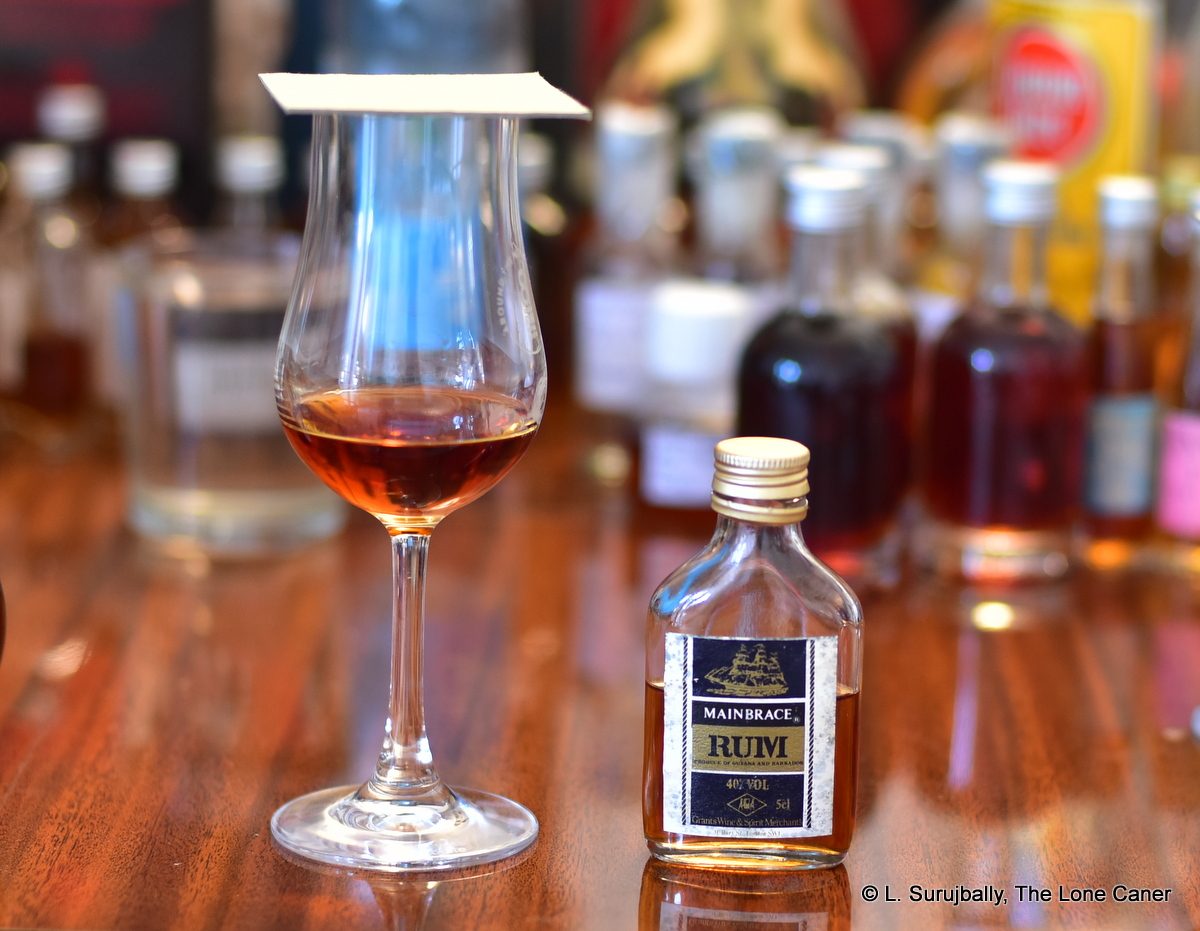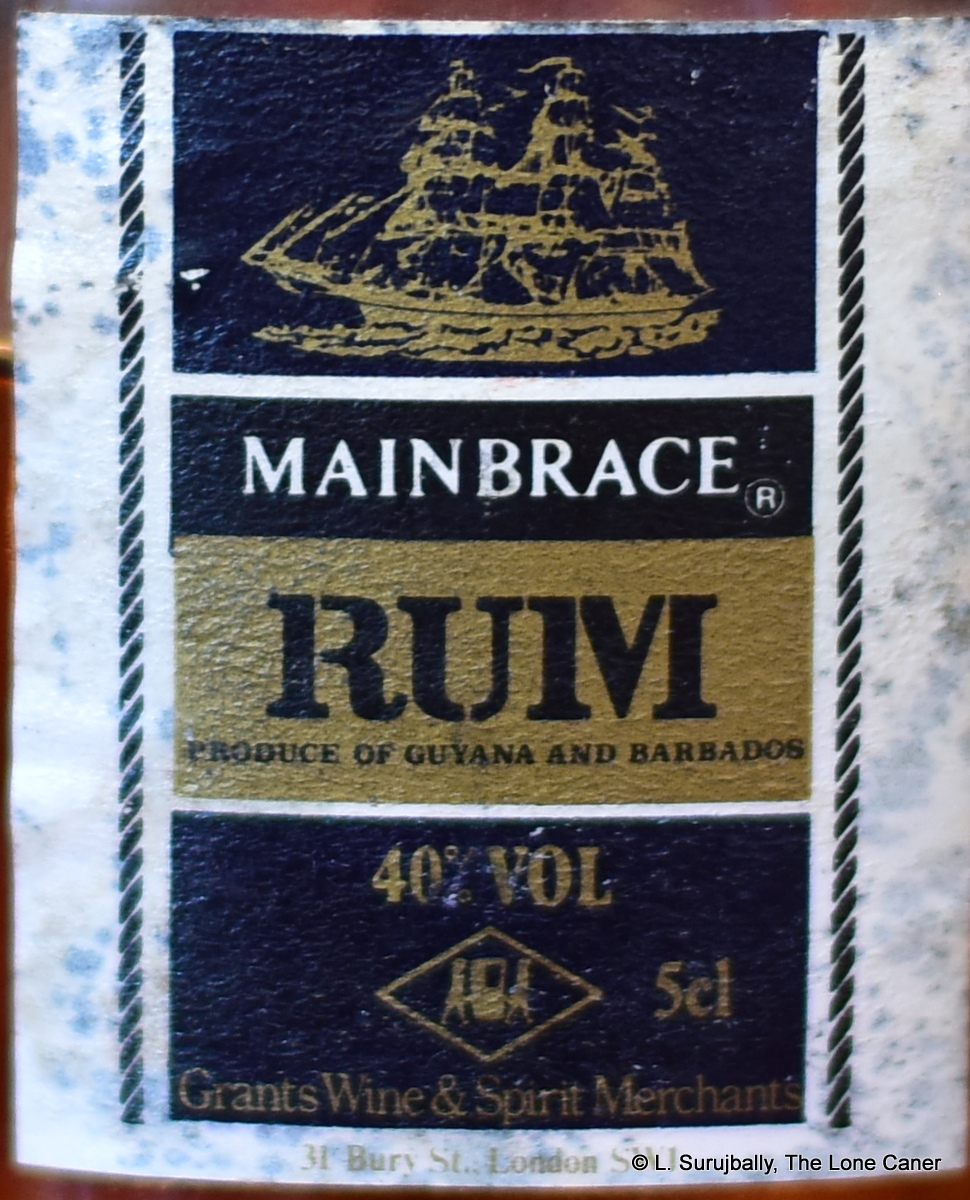
Rumaniacs Review #106 | 0681
Mainbrace Rum is a Guyanese and Barbados blend released by Grants Wine and Spirits Merchants of London, one of many small emporia whose names are now forgotten, who indulged themselves by selling rums they had imported or bought from brokers, and blended themselves. It is unknown which still’s rums from Guyana were used, or which estate provided the rum from Barbados, though the balance of probability favours WIRR (my opinion). Ageing is completely unknown – either of the rum itself, or its constituents.
The Mainbrace name still exists in 2019, and the concept of joining two rums remains. The fancy new version is unlikely to be associated with Grants however, otherwise the heritage would have been trumpeted front and centre in the slick and one-page website that advertises the Guyana-Martinique blended rum now – in fact, the company that makes it is completely missing from the blurbs.
So what happened to Grants? And how old is the bottle really?
 The “Guyana” spelling sets a lower post-independence date of 1966. Grants also released a Navy Rum and a Demerara Rum – both from Guyana, and both at “70º proof”. The address is written differently on their labels though, being “Grants of Saint James” on the Demerara label (Bury Lane is in the area of St. James, and a stone’s throw away from St. James’s Street…and BBR). Grants was still referring to itself as “of St. James” first (and until 1976 at least), but I think it’s the 40% ABV that’s key here, since that only came into effect in the mid 1980s in the UK.
The “Guyana” spelling sets a lower post-independence date of 1966. Grants also released a Navy Rum and a Demerara Rum – both from Guyana, and both at “70º proof”. The address is written differently on their labels though, being “Grants of Saint James” on the Demerara label (Bury Lane is in the area of St. James, and a stone’s throw away from St. James’s Street…and BBR). Grants was still referring to itself as “of St. James” first (and until 1976 at least), but I think it’s the 40% ABV that’s key here, since that only came into effect in the mid 1980s in the UK.
Lastly, a new Grants of Saint James was incorporated in 1993 in Bristol, and when I followed that rabbit run, it led me to Matthew Clark plc, a subsidiary of C&C Group since 2018, and there I found that they had acquired Grants around 1990 and at that point it looks like the brand was retired – no references after that date exist. And so I’ll suggest this is a late 1980s rum.
Colour – Dark Amber
Strength – 40% ABV
Nose – Very nice indeed, you can tell there’s a wooden still shedding its sawdust in here someplace. Cedar, sawdust, pencil shavings, plus fleshy fruits, licorice, tinned peaches, brown sugar and molasses. Thick and sweet but not overly so. That Guyanese component is kicking the Bajan portion big time in this profile, because the latter is well nigh unnoticeable…except insofar as it tones down the aggressiveness of the wooden still (whichever one is represented here).
Palate – Dry and sharp. Then it dials itself down and goes simple. Molasses, coca-cola, fruit (raisins, apricots, cashews, prunes). Also the pencil shavings and woody notes remain, perhaps too much so – the promise of the nose is lost, and the disparity between nose and palate is glaring. There is some salt, caramel, brown sugar and anise here, but it’s all quite faint.
Finish – Short, sweet, aromatic, thick, molasses, brown sugar, anise, caramel and vanilla ice cream. Nice, just too short and wispy.
Thoughts – I could smell this thing all day, because that part is outstanding – but the way is tasted and finished, not so much. I would not have pegged it as a blend, because the Guyanese part of it is so dominant. Overall, the 40% really makes the Mainbrace fall down for me – had it been dialled up ten proof points higher, it would have been outright exceptional.
(#681 | R0106)(82/100)
Historical Note
Anyone who’s got even a smattering of nautical lore has heard of the word “mainbrace” – probably from some swearing, toothless, one-legged, one-eyed, parrot-wearing old salt (often a pirate) in some movie somewhere. It is a term from the days of sail, and refers to the rope used to steady – or brace – the (main)mast, stretching from the bow to the top of the mast and back to the deck. Theoretically, then, “splicing the mainbrace” would mean joining two pieces of mainbrace rope – except that it doesn’t. Although originally an order for one of the most difficult emergency repair jobs aboard a sailing ship, it became a euphemism for authorized celebratory drinking afterward, and then developed into the name of an order to grant the crew an extra ration of rum or grog.
Other
Hydrometer rates it 36.24% ABV, which works out to about 15 g/L additives of some kind.